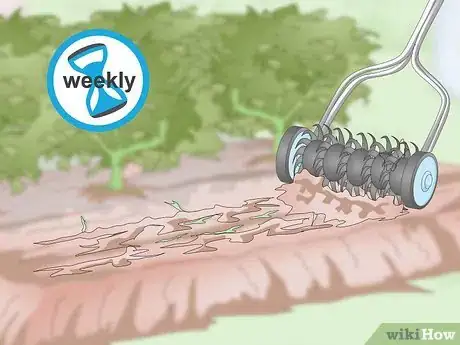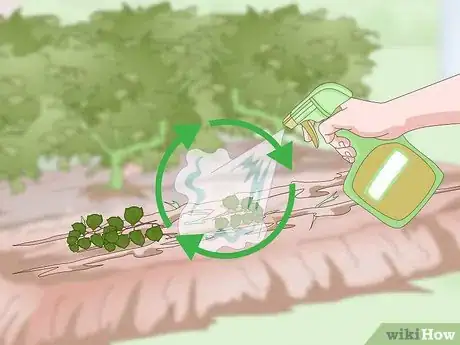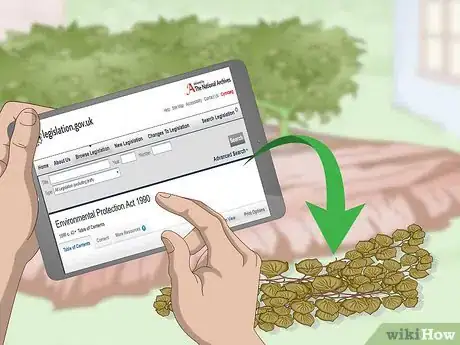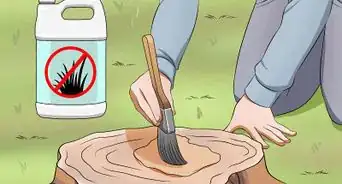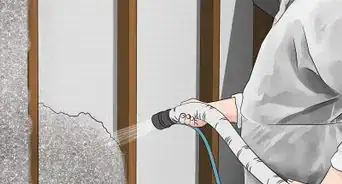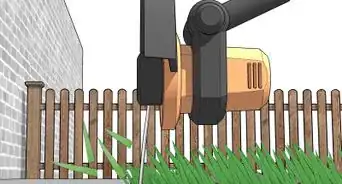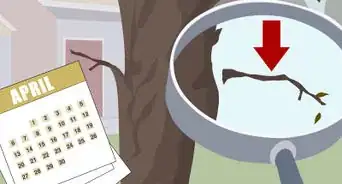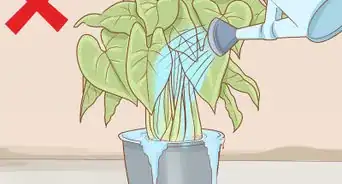This article was co-authored by Lauren Kurtz and by wikiHow staff writer, Sophia Latorre. Lauren Kurtz is a Naturalist and Horticultural Specialist. Lauren has worked for Aurora, Colorado managing the Water-Wise Garden at Aurora Municipal Center for the Water Conservation Department. She earned a BA in Environmental and Sustainability Studies from Western Michigan University in 2014.
This article has been viewed 121,236 times.
Japanese knotweed is an invasive ornamental plant that can be tough to remove. It grows to heights of 7 feet (2.1 m), and the roots can be twice that deep. Japanese knotweed spreads relentlessly and grows back year after year, meaning you should use a multifaceted approach to eradicate it from your lawn or garden. Don’t despair, however: with a little time, effort, and patience you can get rid of Japanese knotweed for good.
Steps
Removing Japanese Knotweed
-
1Cut down and remove the canes. Japanese knotweed will not regrow from cut canes, so it’s important to trim down as many as you can. Use loppers to cut off the canes as close to the ground as possible, then remove the cut pieces from your lawn or garden.[1]
-
2Apply glyphosate weedkiller. Glyphosate weedkiller, like Roundup, can help you get rid of Japanese knotweed. Take care to apply it only to the weeds, as it will kill nearly any vegetation it touches. Spray the weedkiller onto the plants immediately after cutting down the canes.[2]
- If the knotweed has invaded your garden to the point where you can’t spray weedkiller for fear of ruining other plants, paint a glyphosate gel on the individual canes and leaves instead.
- Please note: The WHO considers glyphosate to be a probable human carcinogen. Its use is prohibited in some states and countries. Please check with your local laws and use caution if handling this chemical.
Advertisement -
3Wait 7 days before pulling the weeds after using weedkiller. After applying glyphosate, don’t disturb the plants for at least 7 days. This gives the herbicide time to penetrate the root zone of the plant. Avoid cutting the canes or mowing down the plant for a week. Then, pull out and remove all the dead knotweed, taking care to dig out the deep roots with a pitchfork as well.[3]
-
4Mow the plants down weekly. If you continually cut the remaining aboveground portions of Japanese knotweed, the plant may weaken and die. To remove remaining or regrowing weeds, mow the plants down as short as possible each week to help kill them off.[4]
-
5Reapply glyphosate several times. Unfortunately, using glyphosate once won’t eradicate a Japanese knotweed infestation. It’s recommended that you apply glyphosate weedkiller twice per year: late spring/early summer and again in the early fall.[5]
-
6Contact a professional if all else fails. Japanese knotweed can be quite difficult to remove, so don’t get discouraged if your attempts fail to eradicate it completely. Do an Internet search for companies that specialize in removing this stubborn weed and ask them to inspect your property and give you an estimate for removal. Though you’ll have to shell out some money, many companies guarantee their work, making it a worthwhile expense.[6]
Disposing of Japanese Knotweed
-
1Look up the regulations concerning Japanese knotweed in your area. Because Japanese knotweed is classified as “controlled waste” by the 1990 Environmental Protection Act, many places, like the United Kingdom, require you to dispose of it at a licensed landfill site. Do an Internet search to find out the rules regarding Japanese knotweed disposal for the region where you live.[7]
-
2Gather the knotweed for proper disposal. Fill trash bags with the Japanese knotweed you want to get rid of so it can be easily transported. You can reduce the volume you need to dispose of by burning the weed. Let cut canes of Japanese knotweed dry out for a week or so, then burn them in a controlled setting such as a fire pit. After the burnt waste has cooled, gather it into containers for transport to an approved facility.[8]
- Keep plenty of water nearby to put out the fire, and practice fire safety to ensure no one gets hurt.
- Research and follow all local fire laws and regulations before burning yard waste. Burning is not allowed in all areas.
-
3Arrange for a registered carrier to transport it to a licensed landfill site. If you live somewhere that prohibits you from tossing this weed in the compost or trash bin, you’ll need to arrange for a registered carrier to take the Japanese knotweed to a licensed landfill site. The registered carrier’s vehicle must be thoroughly cleaned after transport as well to keep the rhizomes from spreading to the ground and taking root.[9]
- Do an Internet search to find a registered carrier and licensed landfill site near you.
-
4Throw the knotweed in the trash, if allowed. If there are no regulations dictating how you must dispose of Japanese knotweed, you can simply put it in the trash. Avoid using the dead plants for compost, though, or the knotweed will continue to sprout and spread.
Community Q&A
-
QuestionHow do I get rid of Chinese Knotweed?
 NinoxTop AnswererChinese Knotweed is far more easier to eradicate than Japanese Knotweed. You only need to cut the stems near the ground and throw them in the garbage bin.
NinoxTop AnswererChinese Knotweed is far more easier to eradicate than Japanese Knotweed. You only need to cut the stems near the ground and throw them in the garbage bin.
References
- ↑ http://dnr.wi.gov/topic/invasives/documents/japanese_knotweed_control.pdf
- ↑ https://www.rhs.org.uk/advice/profile?pid=218
- ↑ http://dnr.wi.gov/topic/invasives/documents/japanese_knotweed_control.pdf
- ↑ http://dnr.wi.gov/topic/invasives/documents/japanese_knotweed_control.pdf
- ↑ https://www.rhs.org.uk/advice/profile?pid=218
- ↑ https://www.rhs.org.uk/advice/profile?pid=218
- ↑ https://www.rhs.org.uk/advice/profile?pid=218
- ↑ http://home.bt.com/lifestyle/house-home/gardening/how-do-you-get-rid-of-japanese-knotweed-11364170417724
- ↑ http://home.bt.com/lifestyle/house-home/gardening/how-do-you-get-rid-of-japanese-knotweed-11364170417724
About This Article
To get rid of Japanese knotweed, start by using garden shears to cut off the canes as close to the ground as possible. Then, spray a glyphosate weedkiller, like Roundup, on the remaining plant, making sure not to get it on the surrounding vegetation. After 7 days, pull out all the dead knotweed and dig out the roots with a pitchfork. Once a week, mow the area to trim down any remaining knotweed until the plant weakens and dies. Continue spaying the weeds each spring and fall with weedkiller until it’s gone. For tips from our Horticultural co-author on how to dispose of Japanese knotweed clippings, read on!



